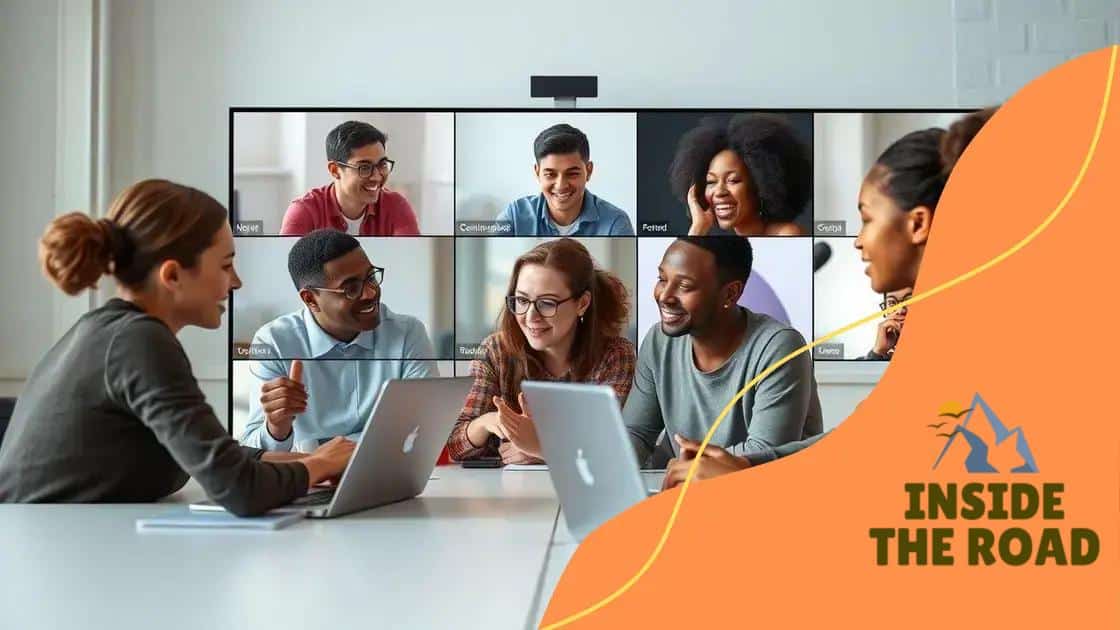the impact of virtual classrooms on student collaboration

The impact of virtual classrooms on student collaboration includes enhanced flexibility, diverse perspectives, and innovative tools, but challenges like technical issues and communication barriers can hinder effective teamwork.
The impact of virtual classrooms on student collaboration is profound, opening up new channels for teamwork and learning. Have you considered how technology transforms group work?
Benefits of virtual classrooms for collaboration
Virtual classrooms come with numerous benefits that can significantly enhance student collaboration. With advanced technology, students have the opportunity to connect and work together like never before. This new way of learning breaks geographical barriers and encourages teamwork.
Flexible Learning Environment
One major advantage is the flexibility that virtual classrooms offer. Students can join classes from anywhere, which helps them collaborate with peers worldwide. This flexibility leads to diverse perspectives and creativity.
- Access from any device, anytime.
- Encouragement of diverse group projects.
- Opportunity to connect with international students.
Moreover, virtual classrooms often utilize various tools that enhance interaction. These tools facilitate real-time collaboration, allowing students to share ideas and resources effortlessly. Instead of feeling isolated, participants can engage in discussions, using chat rooms and forums effectively.
Enhanced Communication
Effective communication is crucial for successful collaboration. Virtual classrooms provide multiple channels for students to express their thoughts. For instance, they might use video calls, breakout rooms, or collaborative documents.
- Video conferencing for direct engagement.
- Shared documents for real-time collaboration.
- Discussion boards for ongoing conversations.
As students engage in virtual classrooms, they develop vital skills necessary for future workplaces. These include teamwork, problem-solving, and adaptability. The collaborative experiences foster a community that encourages participation and support. This sense of belonging is essential for students to thrive academically and personally.
Ultimately, the benefits of virtual classrooms for collaboration extend beyond improved grades. They prepare students for challenges in the real world, where teamwork is often key to success.
Tools enhancing interaction in virtual learning
In today’s digital age, several tools enhance interaction in virtual learning environments. These tools aid students in collaborating more effectively while allowing them to engage deeply with the material. By leveraging technology, educators can stimulate discussions and foster connections.
Video Conferencing Applications
One of the most popular tools is video conferencing applications. They allow for real-time communication, enabling students to participate in live classes. Through platforms like Zoom and Microsoft Teams, learners can ask questions and receive immediate feedback.
- Supports face-to-face interaction.
- Encourages group discussions.
- Facilitates breakout sessions for smaller groups.
Furthermore, chat tools play an essential role in virtual classrooms. These features enable students to share thoughts instantly. They can use chat windows to communicate during lectures, making it easier to clarify concepts without interrupting the flow of the lesson.
Interactive Learning Tools
Interactive learning tools such as Google Docs or Padlet allow for collaborative projects. Students can work on assignments together in real-time, providing opportunities for group work that mimic traditional classroom settings.
- Enables simultaneous editing and idea sharing.
- Helps build teamwork skills.
- Fosters a sense of community through collaboration.
Additionally, using virtual whiteboards can enhance learning experiences. They provide space for brainstorming ideas and visual information sharing. Students can draw or write, making learning interactive and engaging.
As you explore these tools, consider how they can transform your virtual learning experience. By integrating technology effectively, students can enhance their collaboration skills and achieve better learning outcomes.
The role of teachers in facilitating collaboration

Teachers play a critical role in facilitating collaboration among students in virtual classrooms. Their guidance and support can significantly enhance the collaborative learning experience. By fostering an inclusive environment, teachers encourage students to communicate and work together effectively.
Creating a Collaborative Culture
One of the main ways teachers facilitate collaboration is by creating a collaborative culture. This includes establishing rules that promote respect and open dialogue among students. When students feel safe to express their ideas, collaboration becomes more effective.
- Encouraging positive interactions.
- Setting clear expectations for teamwork.
- Building trust within the group.
Additionally, teachers can use various tools to support collaborative work. By integrating technology in their lessons, they help students navigate digital platforms that enhance communication. Through structured activities, teachers can guide students to engage with peers in meaningful ways.
Providing Resources and Guidance
Teachers also provide essential resources that support group projects. Whether it’s access to research materials, technology, or expert guidance, resources enhance the quality of collaboration. When students have the right tools, they can focus on creating and sharing ideas.
- Offering access to online databases.
- Providing tools for project management.
- Facilitating workshops on collaboration skills.
Moreover, teachers must be attentive to group dynamics. They should observe interactions and step in when necessary to mediate conflicts. By addressing issues promptly, teachers can maintain a positive atmosphere for collaboration.
In summary, the involvement of teachers is vital in supporting collaboration in virtual classrooms. Their efforts ensure that students are not only participating but also learning valuable skills for future teamwork scenarios.
Challenges faced in virtual classroom collaboration
Collaboration in virtual classrooms comes with its own set of challenges. Understanding these difficulties can help educators and students navigate them effectively. The shift to online learning has opened doors, but it has also introduced barriers that need attention.
Technical Issues
One of the most common challenges faced is technical issues. Students may experience problems with their internet connection, software compatibility, or hardware malfunctions. These issues can disrupt classes and hinder effective collaboration.
- Connectivity problems leading to missed sessions.
- Software crashes affecting group work.
- Device limitations for accessing tools.
Additionally, not all students have equal access to technology. This digital divide can create disparities in participation. When some students lack the necessary tools, it can lead to frustration and disengagement from the collaborative process.
Communication Barriers
Another significant challenge is communication barriers. Virtual environments can make it difficult for students to express their thoughts clearly. Without face-to-face interaction, non-verbal cues like gestures and facial expressions are often lost.
- Misunderstandings due to text-based communication.
- Difficulty in forming personal connections.
- Limited opportunities for brainstorming ideas.
Moreover, managing group dynamics can be tricky in a virtual setting. Students might struggle with assertiveness or feel overshadowed by more dominant personalities during discussions. This can result in some voices being unheard, which negatively impacts collaboration.
Lastly, motivation can wane in an online classroom. The lack of physical presence may lead students to feel isolated. When students don’t feel motivated or engaged, collaboration suffers significantly, resulting in a less productive learning environment.
Future trends in virtual learning environments
The future of virtual learning environments holds many exciting trends that promise to reshape education. As technology continues to evolve, these trends will enhance how students learn and collaborate.
Increased Use of Artificial Intelligence
One prominent trend is the integration of artificial intelligence into virtual learning platforms. AI can personalize learning experiences by adapting resources to fit individual student needs. This means that students can learn at their own pace and receive tailored support.
- AI-driven assessments to monitor progress.
- Personalized learning paths based on student performance.
- Intelligent tutoring systems providing instant feedback.
Moreover, AI can facilitate administrative tasks, allowing teachers more time to focus on student engagement and collaboration.
Enhanced Collaboration Tools
Another important trend is the development of enhanced collaboration tools. These tools will promote teamwork and communication among students. Expect to see platforms that incorporate virtual reality (VR) and augmented reality (AR) to create immersive learning experiences.
- Virtual field trips that allow exploration of new environments.
- Interactive simulations for real-world problem solving.
- AR tools for collaborative projects and presentations.
As these tools improve, students will be able to engage in dynamic group work that simulates real-world scenarios.
Focus on Social-Emotional Learning
Additionally, the importance of social-emotional learning (SEL) is gaining recognition in virtual environments. Educators will increasingly focus on building community and fostering connections among students, which supports their overall well-being and engagement.
With the right tools and approaches, virtual classrooms will become spaces where students can learn about empathy, cooperation, and communication while collaborating on projects. These skills are essential for success in both academic and professional settings.
As we look ahead, it’s clear that virtual learning environments will continue to evolve. By embracing these trends, educators can create more engaging, effective, and inclusive learning experiences.
FAQ – Frequently Asked Questions about the Impact of Virtual Classrooms on Student Collaboration
What are the main benefits of virtual classrooms for collaboration?
Virtual classrooms offer flexibility, access to diverse perspectives, and a range of collaboration tools that enhance interaction among students.
How do teachers facilitate collaboration in virtual classrooms?
Teachers create a collaborative culture, provide resources, and guide students in using technology effectively to support teamwork.
What challenges do students face in virtual collaboration?
Students may encounter technical issues, communication barriers, and a lack of motivation, which can hinder effective collaboration.
What trends are shaping the future of virtual learning environments?
Key trends include the increased use of artificial intelligence, enhanced collaboration tools like VR and AR, and a greater focus on social-emotional learning.






